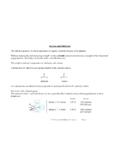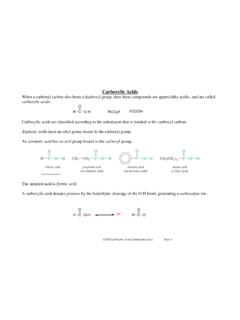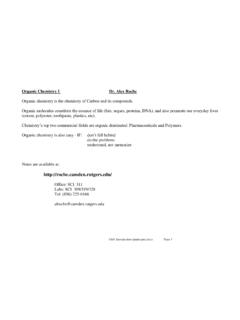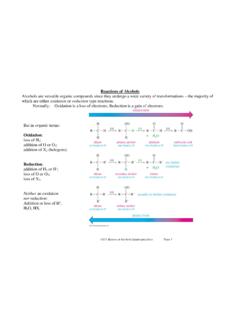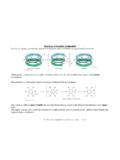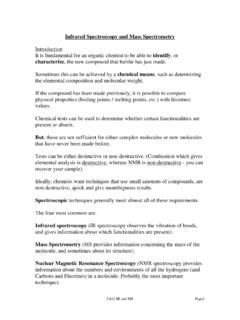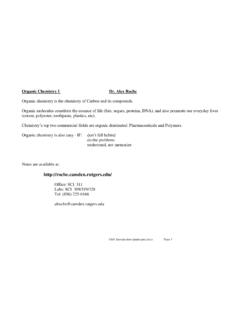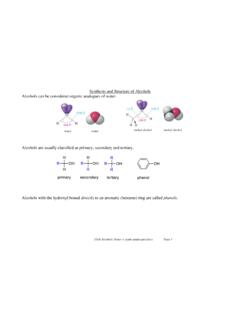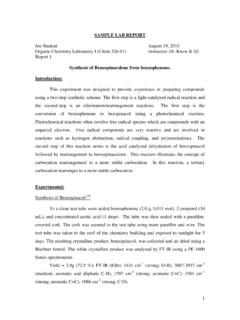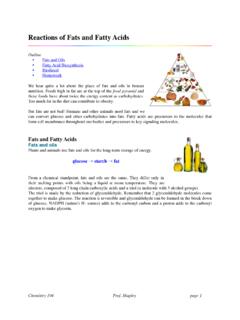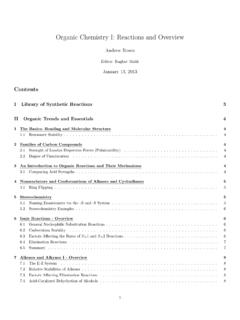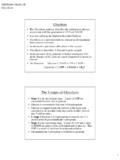Transcription of Reactions of Aromatic Compounds - Rutgers University
1 Ch17 Reactions of Aromatic Compounds (landscape).docx Page1 Reactions of Aromatic Compounds Just like an alkene, benzene has clouds of electrons above and below its sigma bond framework. Although the electrons are in a stable Aromatic system, they are still available for reaction with strong electrophiles. This generates a carbocation which is resonance stabilized (but not Aromatic ). This cation is called a sigma complex because the electrophile is joined to the benzene ring through a new sigma bond. The sigma complex (also called an arenium ion) is not Aromatic since it contains an sp3 carbon (which disrupts the required loop of p orbitals). Ch17 Reactions of Aromatic Compounds (landscape).
2 Docx Page2 The loss of aromaticity required to form the sigma complex explains the highly endothermic nature of the first step. (That is why we require strong electrophiles for reaction). The sigma complex wishes to regain its aromaticity, and it may do so by either by a reversal of the first step ( regenerate the starting material) or by loss of the proton on the sp3 carbon (leading to a substitution product). When a reaction proceeds this way, it is electrophilic Aromatic substitution. There are a wide variety of electrophiles that can be introduced into a benzene ring in this way, and so electrophilic Aromatic substitution is a very important method for the synthesis of substituted Aromatic Compounds .
3 Ch17 Reactions of Aromatic Compounds (landscape).docx Page3 Bromination of Benzene Bromination follows the same general mechanism for the electrophilic Aromatic substitution (EAS). Bromine itself is not electrophilic enough to react with benzene. But the addition of a strong Lewis acid (electron pair acceptor), such as FeBr3, catalyses the reaction, and leads to the substitution product. The bromine molecule reacts with FeBr3 by donating a pair of its electrons to the Lewis acid , which creates a more polar Br-Br bond, and thus a more reactive electrophile. Benzene will now attack this electrophile to generate the sigma complex. Ch17 Reactions of Aromatic Compounds (landscape).docx Page4 Bromide ion from the FeBr4- can act as a weak base to remove the proton, thus generating the Aromatic product, H-Br, and regenerating the catalyst (FeBr3).
4 The formation of the sigma complex is an endothermic and energetically unfavorable process - it is therefore the rate determining step. The second step is exothermic since it regenerates the Aromatic system. The overall reaction is exothermic by about -11 kcal/mol. (-45kJ/mol) Ch17 Reactions of Aromatic Compounds (landscape).docx Page5 Comparison with Alkenes Alkenes react spontaneously with bromine to give addition products. This reaction is exothermic by -29kcal/mol. An analogous addition reaction between benzene and bromine would be endothermic by +2kcal. The destruction of the Aromatic sextet causes this endothermicity. This addition reaction is not observed under normal reaction conditions.
5 The substitution of bromine for hydrogen is an overall exothermic process, but requires a catalyst to convert the bromine molecule into a more reactive electrophile. Ch17 Reactions of Aromatic Compounds (landscape).docx Page6 Chlorination of Benzene The chlorination proceeds analogously to the bromination except this time the Lewis acid catalyst used is AlCl3. Iodination of Benzene The iodination procedure requires an acidic oxidizing agent, such as nitric acid . The nitric acid is a strong oxidizer ( removes electrons, converts iodine into I+), this makes the iodine a much stronger electrophile. 2H+ + 2 HNO3 + I2 2I+ + 2NO2 + 2H2O The nitric acid is consumed in the reaction, it is therefore a reagent, not a catalyst.
6 Ch17 Reactions of Aromatic Compounds (landscape).docx Page7 Nitration of Benzene Benzene will react with hot concentrated nitric acid to produce nitrobenzene. However, this reaction proceeds slowly, which is inconvenient (dangerous) since hot, conc. nitric acid is a powerful oxidizer, and organic Compounds are easily oxidizable. ( potential for BOOM!) A safer reaction involves a mixture of nitric and sulfuric acid . The sulfuric acid behaves as a catalyst, and allows this nitration reaction to proceed at a lower temperature and more quickly ( safer). Sulfuric acid reacts with nitric acid to generate a nitronium ion (NO2+), which is a very powerful electrophile. The reaction mechanism is similar to an acid catalyzed dehydration.
7 Sulfuric acid is a stronger acid than nitric acid , so sulfuric acid protonates nitric acid . After protonation, water is eliminated (good leaving group), and the nitronium ion is generated. Ch17 Reactions of Aromatic Compounds (landscape).docx Page8 The nitronium ion reacts with benzene to form the sigma complex, which then loses a proton to generate the Aromatic product. Sulfonation of Benzene Benzene will react with sulfur trioxide, and in the presence of an acid , aryl sulfonic acids are produced. Sulfur trioxide is very reactive electrophile which will sulfonate benzene. The sigma complex loses a proton to regain its aromaticity, and then the oxyanion becomes protonated. Ch17 Reactions of Aromatic Compounds (landscape).
8 Docx Page9 Desulfonation The sulfonation reaction is reversible, and a sulfonic acid group may be removed ( replaced by hydrogen) from the Aromatic ring by heating in dilute sulfuric acid . (Often just steam is used for this reaction). The mechanism for desulfonation is identical to the sulfonation mechanism, except in the reverse order. Ch17 Reactions of Aromatic Compounds (landscape).docx Page10 Hydrogen-Deuterium Exchange Protonation of the benzene ring may also occur by this mechanism. After protonation has occurred, the sigma complex can lose either of the hydrogens from the sp3 carbon to regain its aromaticity. To prove that reaction has actually occurred, deuterated sulfuric acid can be used.
9 The products will have deuterium substituted for hydrogen. If a large excess of deuterated reagent is used, hexadeuteriobenzene can be produced from this equilibrium reaction. Ch17 Reactions of Aromatic Compounds (landscape).docx Page11 Nitration of Toluene Previously we have concentrated on the Reactions of benzene. Benzene derivatives in a general sense react in the same way that benzene does, although there are some interesting differences. 1) Toluene reacts about 25 times faster than benzene under identical conditions. (We say toluene is activated toward electrophilic Aromatic substitution, and that the methyl group is an activating group). 2) Nitration of toluene generates a mixture of products.
10 The major products are those with substitution at the ortho and para positions. (This preference for o/p substitution makes the methyl group an ortho/para director). The product ratios imply that substitution at each position is not equally likely or energetically favorable). The distribution is not random, since if it were, there would be 40% ortho, 40% meta and 20% para. Ch17 Reactions of Aromatic Compounds (landscape).docx Page12 We have already seen that the RDS for EAS is the first step, which requires the loss of aromaticity to generate the sigma complex. This step is also when the electrophile binds to the ring ( governs the location of substitution). The enhanced rate and substitution pattern for toluene can be explained by considering the structures of the intermediate sigma complexes for substitution at each of the different positions.
